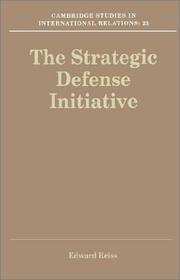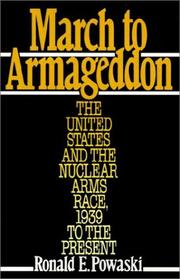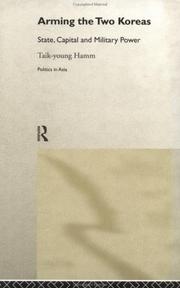| Listing 1 - 6 of 6 |
Sort by
|

ISBN: 0511584873 0511002319 9780511002311 0521410975 9780511584879 9780521054003 9780521410977 0521054001 Year: 1992 Volume: 23 Publisher: Cambridge [England] New York, NY, USA Cambridge University Press
Abstract | Keywords | Export | Availability | Bookmark
 Loading...
Loading...Choose an application
- Reference Manager
- EndNote
- RefWorks (Direct export to RefWorks)
This history of the Strategic Defense Initiative ranges across politics, economics, strategic studies and international relations, and provides the latest research into the SDI interest groups, the distribution of contracts, and the politics of influence. It discusses the wider contexts of 'Star Wars', such as alliance management, marketing, and domestic politics, and its military spin-offs, especially for anti-satellite (ASAT) and 'space control' programmes. The author tests the theoretical literature on the dynamics of the arms race by using SDI as a case study, and draws evidence from sources such as congressional hearings, interviews, the trade press, restricted briefing papers, and documents obtained under the US Freedom of Information Act. The book follows the fortunes of strategic defence into the changed global conditions of the 1990s, following the collapse of the Soviet bloc, the Gulf War, and President Bush's announcement of a refocused SDI, the Global Protection Against Limited Strikes (GPALS).
Strategic Defense Initiative --- Arms race --- Military & Naval Science --- Law, Politics & Government --- Air Forces --- History. --- History --- United States --- Military policy. --- Arms proliferation --- Proliferation of arms --- SDI (Ballistic missile defense system) --- Star Wars (Ballistic missile defense system) --- Security, International --- Arms control --- Arms transfers --- Disarmament --- Military readiness --- Ballistic missile defenses --- Social Sciences --- Political Science

ISBN: 0198020953 1280523328 9786610523320 0195364546 9780198020950 9781280523328 9780195044119 0195044118 0195038789 9780195038781 0195044118 Year: 1987 Publisher: New York, [New York] ; Oxford, [England] : Oxford University Press,
Abstract | Keywords | Export | Availability | Bookmark
 Loading...
Loading...Choose an application
- Reference Manager
- EndNote
- RefWorks (Direct export to RefWorks)
This book traces the evolution of the nuclear arms race from its origin in Roosevelt's decision to develop an atomic bomb to Reagan's decision to continue its expansion in the 1980s.
Arms race. --- Nuclear nonproliferation. --- Nuclear weapons. --- Nuclear weapons --- Arms race --- International Law --- Military & Naval Science --- Military Science - General --- International Cooperation --- Law, Politics & Government --- Arms proliferation --- Proliferation of arms --- Security, International --- Arms control --- Arms transfers --- Disarmament --- Military readiness --- Atomic weapons --- Fusion weapons --- Thermonuclear weapons --- Weapons of mass destruction --- No first use (Nuclear strategy) --- Nuclear arms control --- Nuclear disarmament --- Nuclear warfare --- History --- United States --- Defenses.
Book
ISBN: 0262288095 0585341168 9780585341163 9780262338585 0262338580 9780262680868 9780262288095 Year: 1995 Publisher: Cambridge, Mass. MIT Press
Abstract | Keywords | Export | Availability | Bookmark
 Loading...
Loading...Choose an application
- Reference Manager
- EndNote
- RefWorks (Direct export to RefWorks)
Arms race. --- Arms control. --- World politics --- Arms race --- Arms control --- Armies --- Military & Naval Science --- Law, Politics & Government --- Security, International --- Disarmament --- Military readiness --- Arms proliferation --- Proliferation of arms --- Arms transfers --- Colonialism --- Global politics --- International politics --- Political history --- Political science --- World history --- Eastern question --- Geopolitics --- International organization --- International relations
Book
ISBN: 1532632479 9781532632471 1532632487 9781532632488 Publisher: Wipf and Stock Publishers.
Abstract | Keywords | Export | Availability | Bookmark
 Loading...
Loading...Choose an application
- Reference Manager
- EndNote
- RefWorks (Direct export to RefWorks)
War --- Arms race. --- Arms proliferation --- Proliferation of arms --- Security, International --- Arms control --- Arms transfers --- Disarmament --- Military readiness --- Christianity and war --- Religious aspects --- Christianity. --- Popper-Lynkeus, Josef, --- Popper, Josef, --- Lynkeus, Josef, --- Lynkeus, Josef Popper-, --- Poper-Linḳeʼus, Yosef, --- Linḳeʼus, Yosef Poper-, --- Popper-Lynkeus, Joseph, --- Lynkeus, Joseph Popper-, --- Popper-Linkeus, Iosif, --- Linkeus, Iosif Popper-, --- פופר־לינקאוס, יוסף --- פופר־לינקאוס, יוסף, --- פופר־לינקיאוס, יוסף,

ISBN: 1134620667 1280333553 9786610333554 0203022718 0203169670 9780203169674 0415207924 9780415207928 9780203022719 9781134620616 9781134620654 9781134620661 Year: 1999 Publisher: London Routledge
Abstract | Keywords | Export | Availability | Bookmark
 Loading...
Loading...Choose an application
- Reference Manager
- EndNote
- RefWorks (Direct export to RefWorks)
North Korea has traditionally been seen as militarily superior to South Korea in the long feud between the two nations. This brilliantly argued book taps into a great deal of news interest in North Korea at the moment in the wake of recent hostility against Japan. Hamm controversially shows that the received idea of Koreas military strength is partly a myth created by South Korea to justify a huge programme of rearmament.
Arms race --- Arms proliferation --- Proliferation of arms --- Security, International --- Arms control --- Arms transfers --- Disarmament --- Military readiness --- Korea (North) --- Korea (South) --- USAMGIK --- United States Army Military Government in Korea --- Taehan Minʼguk --- Han guo --- Dae Han Min Kuk --- Tae Han Min Guk --- Daehan-Minʼguk --- South Korea --- Tai Han Min Kook --- South Korean Interim Government --- S.K.I.G. --- SKIG --- Nam Chosŏn Kwado Chŏngbu --- Namjosŏn --- Namjosŏn Kwado Chŏngbu --- Republic of Korea --- Da Han Minguo --- Daehan Min-kuk --- Daikan Minkoku --- ROK --- 대한민국 --- 大韓民國 --- 대한 민국 --- Daehanminguk --- Korean People's Republic --- People's Democratic Republic of Korea --- Koreĭskai︠a︡ Narodno-Demokraticheskai︠a︡ Respublika --- Korea (North Korean Government) --- Democratic People's Republic of Korea --- North Korea --- KNDR --- Chʻao-hsien min chu chu i jen min kung ho kuo --- Koreai Népi Demokratikus Köztársaság --- Korea (Democratic People's Republic) --- K.N.D.R. --- K.R.L.D. --- Korea (People's Democratic Republic) --- Korean People's Democratic Republic --- Chōsen Minshu Shugi Jinmin Kyōwakoku --- Chosŏn Minjujuŭi Inmin Konghwaguk --- KRLD --- Koreańska Republika Ludowo-Demokratyczna --- Kūriyā al-Dīmuqrāṭīyah --- D.P.R.K. --- DPRK --- Corée du Nord --- República Popular Democrática de Corea --- Corea (North) --- North Korean Interim Government --- Chosun Minchu-chui Inmin Konghwa-guk --- Chaoxian minzhu zhuyi renmin gongheguo --- 朝鲜民主主义人民共和国 --- Defenses. --- Armed Forces --- Appropriations and expenditures. --- K9549 --- K9570.90 --- K9570 --- K9578.10 --- K9578.15 --- Korea: International politics, law and relations -- North-South relation --- Korea: Defense and military -- general and history -- North Korea (1945- ) --- Korea: Defense and military -- general and history --- Korea: Defense and military -- weaponry --- Korea: Defense and military -- weaponry -- North Korea --- Ȯmnȯd Solongos --- Emu̇nedu̇ Solungus --- Solongos (South) --- Solungus (South) --- Bu̇gd Naĭramdakh Solongos Uls --- Bu̇gu̇de Nayiramdaqu Solungus Ulus --- I︠U︡zhnai︠a︡ Korei︠a︡ --- Южная Корея --- Korei︠a︡ (South) --- Корея (South) --- BNSU --- БНСУ
Book
ISBN: 9781501766039 9781501766046 1501766031 9781501766022 Year: 2022 Publisher: Ithaca, N.Y. Cornell University Press
Abstract | Keywords | Export | Availability | Bookmark
 Loading...
Loading...Choose an application
- Reference Manager
- EndNote
- RefWorks (Direct export to RefWorks)
In Euromissiles, Susan Colbourn tells the story of the height of nuclear crisis and the remarkable waning of the fear that gripped the globe. In the Cold War conflict that pitted nuclear superpowers against one another, Europe was the principal battleground. Washington and Moscow had troops on the ground and missiles in the fields of their respective allies, the NATO nations and the states of the Warsaw Pact. Euromissiles-intermediate-range nuclear weapons to be used exclusively in the regional theater of war-highlighted how the peoples of Europe were dangerously placed between hammer and anvil. That made European leaders uncomfortable and pushed fearful masses into the streets demanding peace in their time. At the center of the story is NATO. Colbourn highlights the weakness of the alliance seen by many as the most effective bulwark against Soviet aggression. Divided among themselves and uncertain about the depth of US support, the member states were riven by the missile issue. This strategic crisis was, as much as any summit meeting between US president Ronald Reagan and Soviet general secretary Mikhail Gorbachev, the hinge on which the Cold War turned. Euromissiles is a history of diplomacy and alliances, social movements and strategy, nuclear weapons and nagging fears, and politics. To tell that history, Colbourn takes a long view of the strategic crisis-from the emerging dilemmas of allied defense in the early 1950s through the aftermath of the INF Treaty thirty-five years later. The result is a dramatic and sweeping tale that changes the way we think about the Cold War and its culmination.--
Nuclear weapons --- Arms race --- Intermediate-range ballistic missiles --- Cruise missiles --- Cold War. --- History --- North Atlantic Treaty Organization --- Europe --- Soviet Union --- United States --- Foreign relations --- International relations. Foreign policy --- Polemology --- NATO --- anno 1970-1979 --- anno 1980-1989 --- World politics --- Missiles, Cruise --- Guided missiles --- IRBM --- Ballistic missiles --- Arms proliferation --- Proliferation of arms --- Security, International --- Arms control --- Arms transfers --- Disarmament --- Military readiness --- Atomic weapons --- Fusion weapons --- Thermonuclear weapons --- Weapons of mass destruction --- No first use (Nuclear strategy) --- Nuclear arms control --- Nuclear disarmament --- Nuclear warfare --- North Atlantic treaty organisation --- NAVO --- OTAN --- Советский Союз --- Ber. ha-M. --- Związek Socjalistycznych Republik Radzieckich --- ZSRR --- Związek Socjalistycznych Republik Sowieckich --- ZSRS --- Szovjetunió --- TSRS --- Tarybų Socialistinių Respublikų Sąjunga --- SRSR --- Soi︠u︡z Radi︠a︡nsʹkykh Sot︠s︡ialistychnykh Respublik --- SSSR --- Soi︠u︡z Sovetskikh Sot︠s︡ialisticheskikh Respublik --- UdSSR --- Shūravī --- Ittiḥād-i Jamāhīr-i Ishtirākīyah-i Shūrāʼīyah --- Russia (1923- U.S.S.R.) --- Sovetskiy Soyuz --- Soyuz SSR --- Sovetskiĭ Soi︠u︡z --- Soi︠u︡z SSR --- Uni Sovjet --- Union of Soviet Socialist Republics --- USSR --- SSṚM --- Sovetakan Sotsʻialistakan Ṛespublikaneri Miutʻyun --- SSHM --- Sovetakan Sotsʻialistakan Hanrapetutʻyunneri Miutʻyun --- URSS --- Unión de Repúblicas Socialistas Soviéticas --- Berit ha-Moʻatsot --- Rusyah --- Ittiḥād al-Sūfiyītī --- Rusiyah --- Rusland --- Soṿet-Rusland --- Uni Soviet --- Union soviétique --- Zȯvlȯlt Kholboot Uls --- Związek Radziecki --- ESSD --- Sahaphāp Sōwīat --- KhSHM --- SSR Kavširi --- Russland --- SNTL --- PSRS --- Su-lien --- Sobhieṭ Ẏuniẏana --- FSSR --- Unione Sovietica --- Ittiḥād-i Shūravī --- Soviyat Yūniyan --- Russian S.F.S.R. --- NUCLEAR WEAPONS--HISTORY --- ARMS RACE--EUROPE--HISTORY --- CRUISE MISSILES--EUROPE--HISTORY --- COLD WAR --- EUROPE--FOREIGN RELATIONS--USSR --- INTERMEDIATE--RANGE BALLISTIC MISSILES --- NUCLEAR WEAPONS --- HISTORY --- 1900-1999
| Listing 1 - 6 of 6 |
Sort by
|

 Search
Search Feedback
Feedback About UniCat
About UniCat  Help
Help News
News